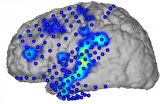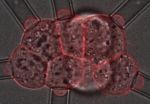Speech recognition from brain activity
Spoken sentences can be reconstructed from activity patterns of human brain surface; 'Brain-to-Text' combines knowledge from neuroscience, medicine, and informatics
2015-06-16
(Press-News.org) This news release is available in German.
Speech is produced in the human cerebral cortex. Brain waves associated with speech processes can be directly recorded with electrodes located on the surface of the cortex. It has now been shown for the first time that is possible to reconstruct basic units, words, and complete sentences of continuous speech from these brain waves and to generate the corresponding text. Researchers at KIT and Wadsworth Center, USA present their "Brain-to-Text" system in the scientific journal Frontiers in Neuroscience (doi: 10.3389/fnins.2015.00217).
"It has long been speculated whether humans may communicate with machines via brain activity alone," says Tanja Schultz, who conducted the present study with her team at the Cognitive Systems Lab of KIT. "As a major step in this direction, our recent results indicate that both single units in terms of speech sounds as well as continuously spoken sentences can be recognized from brain activity."
These results were obtained by an interdisciplinary collaboration of researchers of informatics, neuroscience, and medicine. In Karlsruhe, the methods for signal processing and automatic speech recognition have been developed and applied. "In addition to the decoding of speech from brain activity, our models allow for a detailed analysis of the brain areas involved in speech processes and their interaction," outline Christian Herff und Dominic Heger, who developed the Brain-to-Text system within their doctoral studies.
The present work is the first that decodes continuously spoken speech and transforms it into a textual representation. For this purpose, cortical information is combined with linguistic knowledge and machine learning algorithms to extract the most likely word sequence. Currently, Brain-to-Text is based on audible speech. However, the results are an important first step for recognizing speech from thought alone.
The brain activity was recorded in the USA from 7 epileptic patients, who participated voluntarily in the study during their clinical treatments. An electrode array was placed on the surface of the cerebral cortex (electrocorticography (ECoG)) for their neurological treatment. While patients read aloud sample texts, the ECoG signals were recorded with high resolution in time and space. Later on, the researchers in Karlsruhe analyzed the data to develop Brain-to-Text. In addition to basic science and a better understanding of the highly complex speech processes in the brain, Brain-to-Text might be a building block to develop a means of speech communication for locked-in patients in the future.
INFORMATION:
A video on the functioning of Brain-to-Text:
http://csl.anthropomatik.kit.edu/publikationen_2934.php
The study online:
http://journal.frontiersin.org/article/10.3389/fnins.2015.00217
For further information, please contact:
Kosta Schinarakis, PKM - Science Scout, Phone: +49 721 608 41956, Fax: +49 721 608 43658, E-mail: schinarakis@kit.edu
Karlsruhe Institute of Technology (KIT) is a public corporation pursuing the tasks of a Baden-Wuerttemberg state university and of a national research center of the Helmholtz Association. The KIT mission combines the three core tasks of research, higher education, and innovation. With about 9,400 employees and 24,500 students, KIT is one of the big institutions of research and higher education in natural sciences and engineering in Europe.
Since 2010, the KIT has been certified as a family-friendly university.
This press release is available on the internet at http://www.kit.edu.
The photo of printing quality may be downloaded under http://www.kit.edu or requested by mail to presse@kit.edu or phone +49 721 608-4 7414. The photo may be used in the context given above
[Attachments] See images for this press release:

ELSE PRESS RELEASES FROM THIS DATE:
2015-06-16
For breast cancer to be fatal, the tumor has to send out metastases to other parts of the body. The cancer cells are spread via the blood vessels, and a research team at Lund University in Sweden has now proven that the protein ALK1 determines the extent of the tumor's spread in the body. The higher the levels of the protein on the surface of the blood vessels, the greater their permeability to tumor cells and therefore the greater the risk of metastases.
The new study also shows that the drug Dalantercept can prevent the spread of tumour cells in breast cancer by blocking ...
2015-06-16
This news release is available in German.
In 1915 Albert Einstein formulated the theory of general relativity which fundamentally changed our understanding of gravity. He explained gravity as the manifestation of the curvature of space and time. Einstein's theory predicts that the flow of time is altered by mass. This effect, known as "gravitational time dilation", causes time to be slowed down near a massive object. It affects everything and everybody; in fact, people working on the ground floor will age slower than their colleagues a floor above, by about 10 nanoseconds ...
2015-06-16
The same kind of contraction that fires our muscles also controls a key stage of mammalian embryo development, according to a new study published in Nature Cell Biology. The research, conducted at EMBL Heidelberg, measured and mapped how cells in very early stage embryos bond tightly together. The scientists also discovered a cellular behaviour that hadn't been observed before: cells in the embryo 'dance', each one making the same rhythmic movement.
The focus of the study was a stage of development known as compaction, which takes place when the embryo has eight cells. ...
2015-06-16
In recent decades, enormous successes have been achieved in the field of public health. Three examples of these are the fight against HIV, the reduction in cardiovascular disease, and protection for non-smokers. For Germany to make even better use of the potential of public health, it needs more political support, improved research structures, and stronger international involvement. The German National Academy of Sciences Leopoldina, acatech - the National Academy of Science and Engineering, and the Union of the German Academies of Sciences and Humanities point this out ...
2015-06-16
Starfish have strange talents. Two biology students from University of Southern Denmark have revealed that starfish are able to squeeze foreign bodies along the length of their body cavities and out through their arm tips. This newly discovered talent gives insight into how certain animals are able to quickly heal themselves.
The two biology students, Frederik Ekholm Gaardsted Christensen and Trine Bottos Olsen have discovered a starfish behaviour that has never previously been described in the scientific literature. As part of their studies they were asked to tag some ...
2015-06-16
Chimpanzees and bonobos are the two closest living relatives of the human species - the ultimate tool-using ape. Yet, despite being so closely related on the evolutionary tree, wild chimpanzees and bonobos differ hugely in the way they use tools.
Chimpanzees show the most diverse range of tool use outside of humans. For example, chimpanzees use sticks to 'fish' for ants and termites, stones to crack nuts, as well as tools for grooming and communication. Bonobos rarely use tools and never to forage for food.
The question of 'what makes a tool user?' is a key one in ...
2015-06-16
AUSTIN, Texas -- Improving air quality -- in clean and dirty places -- could reduce pollution-related deaths worldwide by millions of people each year. That finding comes from a team of environmental engineering and public health researchers who developed a global model of how changes in outdoor air pollution could lead to changes in the rates of health problems such as heart attack, stroke and lung cancer.
Outdoor particulate air pollution results in 3.2 million premature deaths annually, more than the combined impact of HIV-AIDS and malaria. The researchers found that ...
2015-06-16
Lisbon, 16 June 2015: Despite a prevalence of anonymous sperm donation in European countries, the use of the same sperm donor for subsequent conceptions is of paramount importance to those couples needing sperm donation to have children. "We found a marked tendency to favour full genetic bonds where possible," said midwife Sara Somers presenting study results today at the Annual Meeting of ESHRE.
The study, performed by Ms Somers and colleagues at the Ghent University Hospital and Ghent University in Belgium, included 34 lesbian and heterosexual couples using sperm donation ...
2015-06-16
Lisbon, 16 June 2015: Dilatation and curettage (D&C) is one of the most common minor surgical procedures in obstetrics and gynaecology, used mainly for miscarriage or terminations.(1) Today, use of the 15-minute procedure is declining in favour of less invasive medical methods, but it still remains common in O&G.
Although D&C is generally considered safe and easy to perform, it is associated with some serious (if rare) side effects, including perforations to the cervix and uterus, infection, and bleeding. Now, an analysis 21 cohort studies which included almost 2 million ...
2015-06-16
Lisbon, 16 June 2015: It is a biological fact that female fertility declines with age - in assisted conception as in natural. Indeed, findings from a 12-year study reported today at the Annual Meeting of ESHRE by Dr Marta Devesa from the Hospital Universitaro Quiron-Dexeus in Barcelona, Spain, showed that in her own clinic cumulative live birth rates following IVF declined from 23.6% in women aged 38-39 years to 1.3% in those aged 44 and over.(1)
Such declines in success rate have been seen in many studies, but are not evident in older patients having egg donation to ...
LAST 30 PRESS RELEASES:
[Press-News.org] Speech recognition from brain activity
Spoken sentences can be reconstructed from activity patterns of human brain surface; 'Brain-to-Text' combines knowledge from neuroscience, medicine, and informatics




